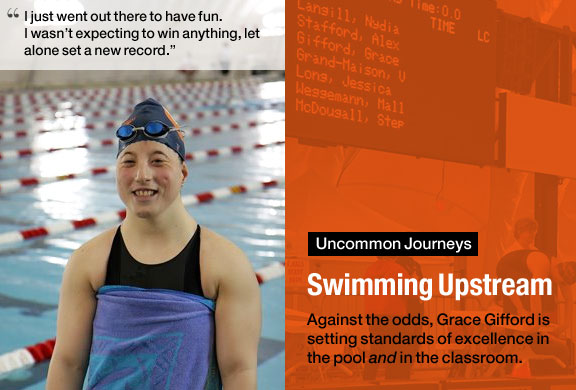Strength and Grace
Grace Gifford

Grace Gifford
Like many children, Grace Gifford ’12 learned to swim at the Y. But for her, getting in the pool was much more than a simple rite of passage. Gifford has a condition called acrocephalopolysyndactyly. As one of the characteristics of the disease, Gifford was born without several essential muscles in each of her knees, leaving her tibias shorter than most people’s.
It was treating this part of the condition that introduced Gifford to the sport she loves. “I got into swimming when I was around eight years old after having leg lengthening surgery,” said Gifford. “Swimming is one of the things they have you do in physical therapy, so I’d go to the YMCA with three other kids that had the same surgery as me. And I loved it.”
When Gifford left the hospital and returned home to Columbus, Indiana, she joined a local club team. Swimming on the team allowed her to continue her rehabilitation and participate in a sport that she was quickly falling in love with. In swimming Gifford had found a release, something she could do with her friends, something she could excel in.
Gifford went on to compete for four years on the varsity swim team in high school. As she neared graduation, her coach suggested that she look into competing in the Paralympics. Her interest piqued, Gifford immediately began a search for all the information that she could find on the Paralympics.
“I read all of the requirements for competing and found out that I met all of them,” she said. “There are different classes of disabilities, based on the extent of your impairment. I compete in the 10th class because I have full range of motion unlike some athletes. It took a while for them to put me in a class, because I can move around like most people because my body has learned how to compensate in certain areas.”
At the 2008 trials in Minneapolis, Gifford discovered she could do more than just compete. She set a new U.S. record in the S9 division of the 200-meter breaststroke with a total time of 3:45.31.
“It was amazing. I just went out there to have fun. I was not expecting to win anything, let alone set a new record,” she said.
Competing in the Pool and the Classroom
Since she came to Lewis & Clark, life in the pool hasn’t changed much for Gifford. In her first year she helped guide Pioneer women’s swim team to a third-place finish at the Northwest Conference Championship.
She has also continued to pursue her dream of swimming for the United States in the Paralympics. At the 2009 U.S. Paralympics Spring Swimming Nationals/Spring Can-Am Championship in Gresham, Oregon, she participated in six individual events. While at nationals, Gifford once again dominated the 200-meter breaststroke, finishing in first place, and took second in both the 50-meter breaststroke and 100-meter freestyle. In the 50-meter breaststroke, Gifford shattered her previous best time of 53.46 seconds, this time touching in at 47.71 seconds.
“It felt good to get out there and compete with my peers,” she said. “This meet helped me get closer to making the U.S. National Team, so that I can hopefully go to the 2012 Paralympics in London.”
Outside of the pool, however, Gifford’s life has changed in some ways since coming to Lewis & Clark.
“I went to a public high school where academics were important, but everyone competed to be on the swim team. Now in college, everyone is competing in the classroom rather than in the pool,” she said. “Don’t get me wrong, my teammates and I are competitive with each other in the pool, but it’s different. We just go out there and have fun and cheer each other on. But in the classroom, everyone competes for the best grades, which is just the polar opposite of high school.”
Planning for the Future
Gifford is going to face more challenges in the coming months. She is set to have hip surgery over the summer to reset her right hip, which sits higher than her left. As a result of the surgery, Gifford is facing the prospect of five weeks of extreme pain and not being able to sit at more than a 70-degree angle. Doctors have told Gifford that it will be nearly three to four months before she gets back to normal, and that there is no guarantee that she’ll be able to return to the water. But if you ask Gifford, there is nothing that will keep her away.
“I have no doubt I’ll be back in the pool after my surgery,” she said. “It might take me a little bit to get used to the way that I swim with my new hip, but it should be fine. Right now my left leg moves normally in the water, and I have to think about moving my right leg a specific way while swimming, so hopefully the surgery will make them work the same. If not, then I’m sure I can make it work. Once I’m healed I’ll resume my training for the 2012 trials.